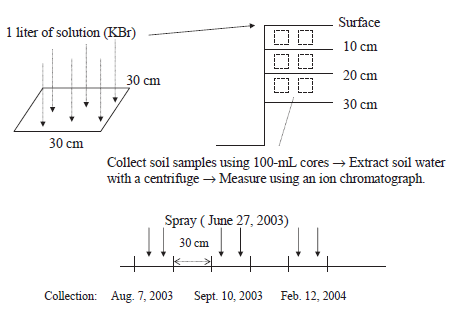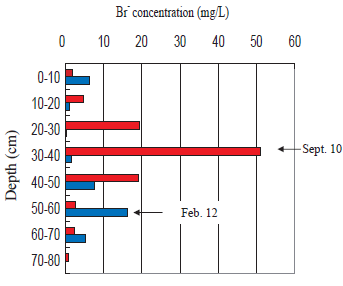Monitoring water infiltration through an unsaturated soil zone using bromide as a tracer in northeast Thailand
Description
It is useful to be able to trace the infiltration of rainfall and the evaporation from the soil surface in order to achieve the effective use of soil water. We employed a method using bromide for this purpose. The conventional method is to collect soil water using a soil water collector which is placed underground; however, this method can be applied only under wet conditions. In this study, we conducted a tracer experiment using bromide in northeast Thailand where the soil mostly remains unsaturated, making it impossible to collect soil water using the conventional method.
We sprayed a solution of bromide (Br- concentration: 0.5 g/L) on sandy soil in northeast Thailand on June 27, 2003. After the elapse of a fixed time, 100-mL core samples were collected at depth intervals of 10 cm. The soil samples were sent to a laboratory where the soil water was extracted using a centrifuge at a force of about 4000 rpm, corresponding to about pF 3.5. After extraction, the Br- concentration was determined using an ion-chromatograph analyzer (Fig. 1).
In the soil samples collected on August 7, the Br- peak concentration was at 0-10 cm, indicating that the Br- had remained at the soil surface. Assuming that the total rainfall between June 27 and August 7, which amounted to about 170 mm, had all been lost through evaporation, the average rate of evaporation during this period was calculated as being about 4 mm/day (Table 1).
In the soil samples collected on September 10, the peak Br- concentration appeared in the 30-40 cm deep layer, indicating that the Br- had moved downward due to the piston flow induced by the infiltration of rainfall and with dispersion due to differences in the Br- concentration. We inferred in this case that the amount of water in the soil above the depth of the peak concentration was equal to the amount of rainfall infiltration between August 7 and September 10. The total rainfall during this period was about 290 mm, so the amount of rainfall infiltration was calculated to be about 100 mm and the amount of evaporation about 190 mm (Fig. 2, Table 1).
In the samples collected on February 12, a proportion of the Br- that had infiltrated into the soil returned to the surface, resulting in the accumulation of salts at the surface (Fig. 2, Table 1).
Figure, table
-
Fig. 1. Application and collection of bromide. -
Fig. 2 Br- concentration in soil water.
- Affiliation
-
Japan International Research Center for Agricultural Sciences Crop Production and Environment Division
- Classification
-
Technical A
- Term of research
-
FY2004(FY2002~2004)
- Responsible researcher
-
HAMADA Hiromasa ( Crop Production and Environment Division )
- ほか
- Publication, etc.
-
Hamada H. et al.(2005): Use of bromide to trace infiltration of rainfall through sandy soil in northeast Thailand. JARQ, 39(1), 29-35.
Use of Bromide to Trace Infiltration of Rainfall through Sandy Soil in Northeast Thailand
Hamada H. Abenney-Mickson S. and Komae T. (2004): Influence of inundation of ground surface on 222Rn concentrations in shallow groundwater. Radioisotopes, 53, 469-475.
- Japanese PDF
-
2004_08_A3_ja.pdf561.71 KB


